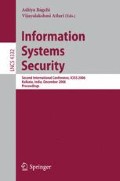Abstract
A phenomenal growth in the number of credit card transactions, especially for on-line purchases, has also led to a substantial rise in fraudulent activities. Implementation of efficient fraud detection systems has thus become imperative for all credit card companies in order to minimize their losses. In real life, fraudulent transactions could be interspersed with genuine transactions and simple pattern matching techniques are not often sufficient to detect the fraudulent transactions efficiently. In this paper, we propose a hybrid approach in which anomaly detection and misuse detection models are combined. Sequence alignment is used to determine similarity of an incoming sequence of transactions to both a genuine card holder’s sequence as well as to sequences generated by a validated fraud model. The scores from these two stages are combined to determine if a transaction is genuine or not. We use stochastic models for studying the performance of the system.
Access this chapter
Tax calculation will be finalised at checkout
Purchases are for personal use only
Preview
Unable to display preview. Download preview PDF.
References
Global Consumer Attitude Towards Online Shopping (April 28, 2006), http://www2.acnielsen.com/reports/documents/2005_cc_onlineshopping.pdf
Statistics for General and Online Card Fraud (April 22, 2006), http://www.epaynews.com/statistics/fraud.html
Business news on Preventing card fraud BBC NEWS (March 8, 2005), http://news.bbc.co.uk/2/hi/business/3256799.stm
Ghosh, S., Reilly, D.L.: Credit Card Fraud Detection with a Neural-Network. In: Proceedings of the Annual International Conference on System Science, pp. 621–630 (1994)
Stolfo, S.J., Fan, D.W., Lee, W., Prodromidis, A.L.: Credit Card Fraud Detection Using Meta-Learning: Issues and Initial Results. In: Proceedings of the Workshop on AI Methods in Fraud and Risk Management (1997)
Aleskerov, E., Freisleben, B., Rao, B.: CARDWATCH: A Neural Network Based Database Mining System for Credit Card Fraud Detection. In: Proceedings of the IEEE/IAFE, pp. 220–226 (1997)
Fan, W., Prodromidis, A.L., Stolfo, S.J.: Distributed Data Mining in Credit Card Fraud Detection. In: Proceedings of IEEE Intelligent Systems, pp. 67–74 (1999)
Brause, R., Langsdorf, T., Hepp, M.: Neural Data Mining for Credit Card Fraud Detection. In: International Conference on Tools with Articial Intelligence, pp. 103–106 (1999)
Chiu, C., Tsai, C.: A Web Services-Based Collaborative Scheme for Credit Card Fraud Detection. In: Proceedings of the IEEE International Conference on e-Technology, e-Commerce and e-Service, pp. 177–181 (2004)
Phua, C., Lee, V., Smith, K., Gayler, R.: A Comprehensive Survey of Data Mining-based Fraud Detection Research. In: Proceedings of the Articial Intelligence (2005)
Vatsa, V., Sural, S., Majumdar, A.K.: A Game- Theoretic Approach to Credit Card Fraud Detection. In: Jajodia, S., Mazumdar, C. (eds.) ICISS 2005. LNCS, vol. 3803, pp. 263–276. Springer, Heidelberg (2005)
Takeda, K.: The application of bioinformatics to network intrusion detection, Security Technology. In: 39th Annual International Conference (CCST) IEEE, pp. 130–132 (2005)
Coul, S., Branch, J., Szymanski, B., Breimer, E.: Intrusion Detection: A Bioinformatics Approach. In: Proceedings of the 19th Annual Computer Security Applications Conference (ACSAC) IEEE, pp. 24–33 (2003)
Needleman, S.B., Wunsch, C.D.: A general method applicable to the search for similarities in the amino acid sequence of two proteins. Journal of Molecular Biology, 443–453 (1970)
Smith, T.F., Waterman, M.S.: Identification of common molecular subsequences. Journal of Molecular Biology, 195–197 (1981)
Altschul, S.F., Gish, W., Miller, W., Myers, W., Lipman, J.: Basic Local Alignment Search Tool. Journal of Molecular Biology, 403–410 (1990)
Author information
Authors and Affiliations
Editor information
Editors and Affiliations
Rights and permissions
Copyright information
© 2006 Springer-Verlag Berlin Heidelberg
About this paper
Cite this paper
Kundu, A., Sural, S., Majumdar, A.K. (2006). Two-Stage Credit Card Fraud Detection Using Sequence Alignment. In: Bagchi, A., Atluri, V. (eds) Information Systems Security. ICISS 2006. Lecture Notes in Computer Science, vol 4332. Springer, Berlin, Heidelberg. https://doi.org/10.1007/11961635_18
Download citation
DOI: https://doi.org/10.1007/11961635_18
Publisher Name: Springer, Berlin, Heidelberg
Print ISBN: 978-3-540-68962-1
Online ISBN: 978-3-540-68963-8
eBook Packages: Computer ScienceComputer Science (R0)

